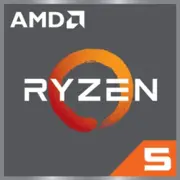AMD Ryzen 5 4600GE

AMD Ryzen 5 4600GE: Comprehensive Review of the Processor for Energy-Efficient Systems
Relevant as of April 2025
Key Features: Architecture and Performance
The AMD Ryzen 5 4600GE processor, released in 2020, remains a popular choice for compact and energy-efficient PCs thanks to its Zen 2 architecture and 7nm technology process. This is a 6-core chip with 12 threads, a base clock speed of 3.3 GHz, and a turbo boost of up to 4.2 GHz. It has 8 MB of L3 cache, and the TDP ranges from 10 to 45 watts, allowing flexible power consumption management.
Key Features:
- Integrated Radeon Vega 7 Graphics (448 cores, clock speed up to 1900 MHz) — suitable for light gaming and multimedia work.
- Support for PCIe 3.0 (compared to PCIe 4.0 in the Ryzen 5000 series) — a limitation for next-gen SSDs, but sufficient for most tasks.
- Precision Boost 2 and SMT technologies — automatic overclocking and efficient multithreading.
Performance:
In the Geekbench 6 (2025) test, the processor scores 1486 points in single-core mode and 6287 in multi-core. This level is adequate for office applications, rendering in Blender, and streaming in OBS. In games at 1080p resolution (such as CS2 or Fortnite), the Vega 7 delivers 40-60 FPS at medium settings.
Compatible Motherboards: Sockets and Chipsets
The Ryzen 5 4600GE uses the AM4 socket, ensuring compatibility with motherboards based on the following chipsets:
- A520 — budget option without overclocking (from $60).
- B550 — optimal choice with support for PCIe 4.0 for GPUs and NVMe (from $90).
- X570 — premium segment with enhanced power delivery and extended ports (from $150).
Recommendations:
- For mini-PCs, compact mITX boards like the ASRock B550M-ITX/ac ($120) are suitable.
- When choosing, check the BIOS version: boards from 2022 and later support Zen 2 "out of the box."
Supported Memory: DDR4 and Optimization
The processor operates with DDR4-3200 (officially), but many users overclock the memory to 3600 MHz for a performance boost of 5-8%.
Tips:
- Choose dual-channel kits (2×8 GB or 2×16 GB).
- Optimal models: Crucial Ballistix 3200 MHz CL16 ($55 for 16 GB) or G.Skill Ripjaws V 3600 MHz CL18 ($70).
Power Supplies: Power Calculation
With a TDP of 35 watts (real-world loads rarely exceed 65 watts at peak), even with a discrete graphics card like the NVIDIA RTX 3050 (130 watts), a power supply of 450-550 watts is sufficient.
Examples:
- For systems without a graphics card: be quiet! Pure Power 11 400W ($60).
- With a graphics card: Corsair CX550M ($70, 80+ Bronze).
Pros and Cons of the Ryzen 5 4600GE
Advantages:
- Low power consumption — ideal for HTPCs or office PCs.
- Decent integrated graphics.
- Availability (price in 2025 — $120–140).
Disadvantages:
- No PCIe 4.0 — slower for next-gen NVMe SSDs.
- Limited upgrade potential (the AM4 socket is becoming outdated).
Use Cases
1. Office and Multimedia: Smooth operation in Chrome with 20+ tabs, 4K video in VLC.
2. Light Gaming: GTA V, Rocket League, Minecraft — 50–60 FPS at medium settings.
3. Home Server: Low power consumption and support for virtualization via AMD-V.
Comparison with Competitors
- Intel Core i5-12400T (2022): Better single-threaded performance (Geekbench 6 Single Core — 1650), but more expensive ($160) and lacks integrated graphics in some models.
- Ryzen 5 5600G (2021): Zen 3 architecture, PCIe 3.0, Vega 7 — 10-15% performance boost in games, but higher price ($170).
Practical Assembly Tips
1. Cooling: The stock cooler is sufficient, but for quieter operation, choose the Noctua NH-L9a-AM4 ($45).
2. Case: Mini formats (Fractal Design Node 202) for media centers.
3. Storage: Kingston NV1 1 TB SSD ($65) — balance of speed and capacity.
Final Conclusion: Who is the Ryzen 5 4600GE Suitable For?
This processor is an excellent choice for:
- Budget Builds (complete system — $400–500).
- Energy-Efficient Systems (NAS, home server).
- Office PCs with enough headroom for multitasking.
In 2025, the 4600GE remains relevant due to its low price and balanced performance, but for gaming or professional tasks, it is better to consider models with PCIe 4.0 and Zen 3/4 architecture.
Basic
CPU Specifications
Memory Specifications
GPU Specifications
Miscellaneous
Benchmarks
Compared to Other CPU
Share in social media
Or Link To Us
<a href="https://cputronic.com/cpu/amd-ryzen-5-4600ge" target="_blank">AMD Ryzen 5 4600GE</a>